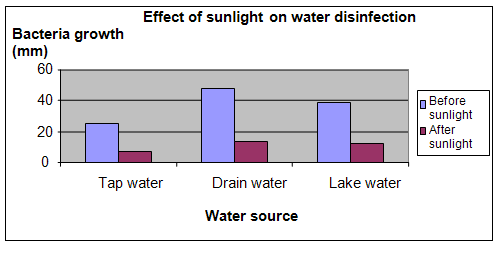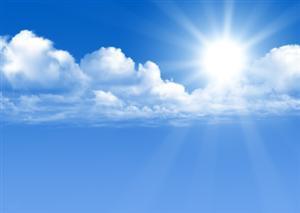| Complexity level: | 8 |
| Project cost ($): | 20 |
| Time required: | 1 day to prepare, 7 days for science fair project |
| Material availability: | Easily found |
| Safety concerns: | The bacteria should be destroyed before being disposed of. Pour some bleach into the petri dishes to kill all bacteria before disposable. |
Hypothesis
The rate of bacteria growth in water will decrease after exposure to sunlight.
Overview
Solar Water Disinfection (SODIS)
One of the easiest ways of disinfecting drinking water is to fill the water in a transparent bottle and then place it under sunlight. If the water in the bottle is exposed to the sun for a sufficient amount of time, almost all the bacteria in it will be killed. This is possible because the ultraviolet radiation, plus thehigh temperatures, would be enough to kill all micro-organisms found in the water.
This method of disinfecting drinking water is gaining popularity in underdeveloped nations where sophisticated water filtration systems and clean drinking water are not readily available. The technique is known as "Solar Water Disinfection" (SODIS). It is very simple and economical because no initial investment or maintenance is required. Basically, only an empty bottle and sunlight is needed.
One setback for this method is that it does not work when strong sunlight is unavailable. The water needs 6 to 12 hours of exposure to sunlight before it becomes safe to drink. This method is only suitable for killing micro-organisms in the water. It does not remove other chemicals or heavy metal pollutants in the water.
Scientific Terms
Materials
The materials required for this science fair project:
- 6 agar petri dishes
- 6 disinfected swabs
- 1 bottle of disinfected water
- 1 transparent bottle filled with tap water
- 1 transparent bottle filled with water collected from a drain
- 1 transparent bottle filled with water from a lake
- 1 ruler
- 1 marker pen
Procedure
1. For this science fair project, the independent variable is the source of water – tap, drain and lake. The dependent variable is the amount of bacteria growth in the petri dish. This is determined by measuring the size of the bacteria growth using a ruler. The constants (control variables) are the room temperature, the amount of sunlight and method of preparation of the petri dish agar.
2. The 12 petri dishes prepared with agar are stored in a refrigerator. The petri dishes are brought to room temperature before the start of the science fair project by taking them out of the refrigerator and allowing them to settle at room temperature. The petri dishes are labeled "Tap 1", "Drain 1", "Lake 1", "Tap 2", "Drain 2" and "Lake 2".
3. The swab is washed with the disinfected water. It is then dipped into the tap water in the bottle and rubbed on the petri dish labeled Tap 1. Similarly, other swabs are dipped into the drain water and lake water before being rubbed on the petri dishes labeled drain 1 and lake 1. The cover is closed and the 3 petri dishes are kept in a cool shady place for the bacteria to grow. The size of the bacteria colony growth is measured after 5 days and recorded in the below table
4. The 3 transparent bottles are then placed under direct sunlight for 2 days. Procedure 3 is then repeated using water from the bottles and the petri dishes labeled Tap 2, Drain 2 and Lake 2.
5. At the end of the 5th day, the diameter of the bacteria colony is measured and recorded.

Results
The results showed that the amount of bacteria growth in the petri dishes was much lower for the water that had been exposed to sunlight for 5 days.
|
Condition |
Bacteria growth in petri dish after 5 days (mm) |
||
|
Tap water |
Drain water |
Lake water |
|
|
Before sunlight |
25 |
48 |
39 |
|
After sunlight |
7 |
14 |
12 |
The chart below represents the results of our science fair project.

Conclusion
Our hypothesis that the rate of bacteria growth in water will decrease after exposure to sunlight, has been proven to be true.
Almost 30% of the world’s human population does not have access to clean drinking water. Most of these people live in developing countries. Lives of many young and old are lost due to food poisoning and other water borne diseases caused by drinking infected water. SODIS is a practical and cheap solution to provide the poor with safe and clean drinking water.
Also consider
Try to repeat the science fair project by placing the bottles in the sun for different lengths of time, to ascertain the actual amount of time required to completely disinfect the water in the bottle.
The science fair project can also be repeated using different colored bottles, or by comparing whether there is a difference between glass and plastic bottles.
References
Solar water disinfection - http://www.freedrinkingwater.com/water_quality/quality1/1-explain-solar-water-disinfection.htm
SODIS: How does it work? - http://www.sodis.ch/methode/anwendung/index_EN

